
Automating Trading Strategies in MQL5 (Part 17): Mastering the Grid-Mart Scalping Strategy with a Dynamic Dashboard
Introduction
In our previous article (Part 16), we automated the Midnight Range Breakout with the Break of Structure strategy to capture price breakouts. Now, in Part 17, we focus on automating the Grid-Mart Scalping Strategy in MetaQuotes Language 5 (MQL5), developing an Expert Advisor that executes grid-based Martingale trades and features a dynamic dashboard for real-time monitoring. We will cover the following topics:
By the end of this article, you will have a fully functional MQL5 program that scalps markets with precision and visualizes trading metrics—let’s dive in!
Understanding the Grid-Mart Scalping Strategy
The Grid-Mart Scalping Strategy employs a grid-based Martingale approach, placing buy or sell orders at fixed price intervals (e.g., 2.0 pips) to capture small profits from market fluctuations, while increasing lot sizes after losses to recover capital quickly. It relies on high-frequency trading, targeting modest gains (e.g., 4 pips) per trade. However, it requires careful risk management due to the exponential lot size growth, which is capped by configurable limits like maximum grid levels and daily drawdown thresholds. This strategy thrives in volatile markets but demands precise configuration to avoid significant drawdowns during prolonged trends.
Our implementation plan involves creating an MQL5 Expert Advisor to automate the Grid-Mart strategy by calculating grid intervals, managing lot size progression, and executing trades with predefined stop-loss and take-profit levels. The program will feature a dynamic dashboard to display real-time metrics, such as spread, active lot sizes, and account status, with color-coded visuals to aid decision-making. Robust risk controls, including drawdown limits and grid size restrictions, will ensure consistent performance across market conditions. In a nutshell, this is what we aim to create.
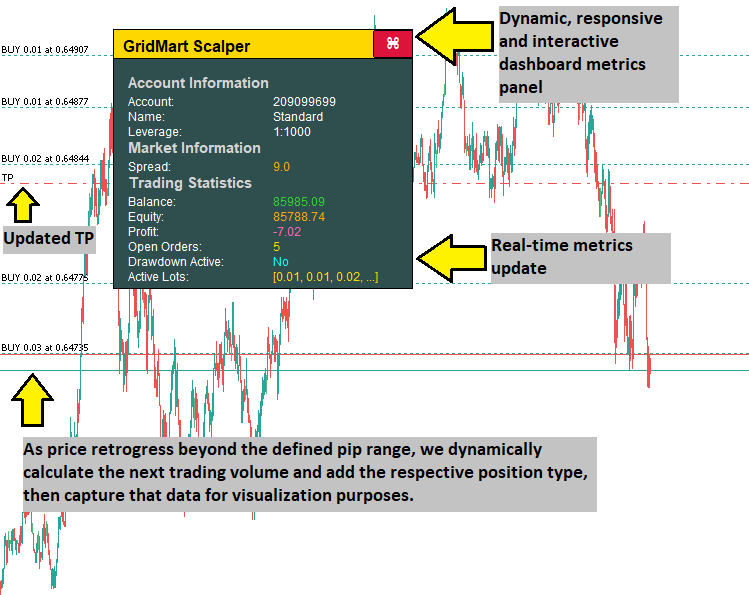
Implementation in MQL5
To create the program in MQL5, open the MetaEditor, go to the Navigator, locate the Indicators folder, click on the "New" tab, and follow the prompts to create the file. Once it is made, in the coding environment, we will need to declare some global variables that we will use throughout the program.
//+------------------------------------------------------------------+ //| GridMart Scalper MT5 EA.mq5 | //| Copyright 2025, Allan Munene Mutiiria. | //| https://t.me/Forex_Algo_Trader | //+------------------------------------------------------------------+ #property copyright "Copyright 2025, Allan Munene Mutiiria." #property link "https://t.me/Forex_Algo_Trader" #property version "1.00" #include <Trade/Trade.mqh> //--- Declare trade object to execute trading operations CTrade obj_Trade; //--- Trading state variables double dailyBalance = 0; //--- Store the daily starting balance for drawdown monitoring datetime dailyResetTime = 0; //--- Track the last daily reset time bool tradingEnabled = true; //--- Indicate if trading is allowed based on drawdown limits datetime lastBarTime = 0; //--- Store the timestamp of the last processed bar bool hasBuyPosition = false; //--- Flag if there is an active buy position bool hasSellPosition = false; //--- Flag if there is an active sell position bool openNewTrade = false; //--- Signal when a new trade should be opened int activeOrders = 0; //--- Count the number of active orders double latestBuyPrice = 0; //--- Store the price of the latest buy order double latestSellPrice = 0; //--- Store the price of the latest sell order double calculatedLot = 0; //--- Hold the calculated lot size for new orders bool modifyPositions = false; //--- Indicate if position SL/TP need modification double weightedPrice = 0; //--- Track the weighted average price of open positions double targetTP = 0; //--- Store the target take-profit price double targetSL = 0; //--- Store the target stop-loss price bool updateSLTP = false; //--- Signal when SL/TP updates are needed int cycleCount = 0; //--- Count the number of trading cycles double totalVolume = 0; //--- Accumulate the total volume of open positions bool dashboardVisible = true; //--- Control visibility of the dashboard //--- Dashboard dragging and hover state variables bool panelDragging = false; //--- Indicate if the dashboard is being dragged int panelDragX = 0; //--- Store the X-coordinate of the mouse during dragging int panelDragY = 0; //--- Store the Y-coordinate of the mouse during dragging int panelStartX = 0; //--- Store the initial X-position of the dashboard int panelStartY = 0; //--- Store the initial Y-position of the dashboard bool closeButtonHovered = false; //--- Track if the close button is hovered bool headerHovered = false; //--- Track if the header is hovered input group "Main EA Settings" input string EA_NAME = "GridMart Scalper"; // EA Name input bool CONTINUE_TRADING = true; // Continue Trading After Cycle input int MAX_CYCLES = 1000; // Max Trading Cycles input int START_HOUR = 0; // Start Trading Hour input int END_HOUR = 23; // End Trading Hour input int LOT_MODE = 1; // Lot Mode (1=Multiplier, 2=Fixed) input double BASE_LOT = 0.01; // Base Lot Size input int STOP_LOSS_PIPS = 100; // Stop Loss (Pips) input int TAKE_PROFIT_PIPS = 3 ; // Take Profit (Pips) input double GRID_DISTANCE = 3.0; // Grid Distance (Pips) input double LOT_MULTIPLIER = 1.3; // Lot Multiplier input int MAX_GRID_LEVELS = 30; // Max Grid Levels input int LOT_PRECISION = 2; // Lot Decimal Precision input int MAGIC = 1234567890; // Magic Number input color TEXT_COLOR = clrWhite; // Dashboard Text Color input group "EA Risk Management Settings" input bool ENABLE_DAILY_DRAWDOWN = false; // Enable Daily Drawdown Limiter input double DRAWDOWN_LIMIT = -1.0; // Daily Drawdown Threshold (-%) input bool CLOSE_ON_DRAWDOWN = false; // Close Positions When Threshold Hit input group "Dashboard Settings" input int PANEL_X = 30; // Initial X Distance (pixels) input int PANEL_Y = 50; // Initial Y Distance (pixels) //--- Pip value for price calculations double pipValue; //--- Dashboard constants const int DASHBOARD_WIDTH = 300; //--- Width of the dashboard in pixels const int DASHBOARD_HEIGHT = 260; //--- Height of the dashboard in pixels const int HEADER_HEIGHT = 30; //--- Height of the header section const int CLOSE_BUTTON_WIDTH = 40; //--- Width of the close button const int CLOSE_BUTTON_HEIGHT = 28; //--- Height of the close button const color HEADER_NORMAL_COLOR = clrGold; //--- Normal color of the header const color HEADER_HOVER_COLOR = C'200,150,0'; //--- Header color when hovered const color BACKGROUND_COLOR = clrDarkSlateGray; //--- Background color of the dashboard const color BORDER_COLOR = clrBlack; //--- Border color of dashboard elements const color SECTION_TITLE_COLOR = clrLightGray; //--- Color for section titles const color CLOSE_BUTTON_NORMAL_BG = clrCrimson; //--- Normal background color of the close button const color CLOSE_BUTTON_HOVER_BG = clrDodgerBlue; //--- Hover background color of the close button const color CLOSE_BUTTON_NORMAL_BORDER = clrBlack; //--- Normal border color of the close button const color CLOSE_BUTTON_HOVER_BORDER = clrBlue; //--- Hover border color of the close button const color VALUE_POSITIVE_COLOR = clrLimeGreen; //--- Color for positive values (e.g., profit, low spread) const color VALUE_NEGATIVE_COLOR = clrOrange; //--- Color for negative or warning values (e.g., loss, high spread) const color VALUE_LOSS_COLOR = clrHotPink; //--- Color for negative profit const color VALUE_ACTIVE_COLOR = clrGold; //--- Color for active states (e.g., open orders, medium spread) const color VALUE_DRAWDOWN_INACTIVE = clrAqua; //--- Color for inactive drawdown state const color VALUE_DRAWDOWN_ACTIVE = clrRed; //--- Color for active drawdown state const int FONT_SIZE_HEADER = 12; //--- Header text font size (pt) const int FONT_SIZE_SECTION_TITLE = 11; //--- Section title font size (pt) const int FONT_SIZE_METRIC = 9; //--- Metric label/value font size (pt) const int FONT_SIZE_BUTTON = 12; //--- Button font size (pt)
Here, we implement the strategy in MQL5, initializing the program’s core components to automate grid-based Martingale trades and support a dynamic dashboard. We declare the "CTrade" object as "obj_Trade" using "#include <Trade/Trade.mqh>" to manage trade execution. We define variables like "dailyBalance" to track account balance, "lastBarTime" to store bar timestamps with the iTime function, "hasBuyPosition" and "hasSellPosition" to flag active trades, and "activeOrders" to count open positions.
We set inputs like "GRID_DISTANCE = 3.0" for grid intervals, "LOT_MULTIPLIER = 1.3" for lot scaling, and "TAKE_PROFIT_PIPS = 3" for profit targets, using "MAGIC = 1234567890" to identify trades. We include "ENABLE_DAILY_DRAWDOWN" and "DRAWDOWN_LIMIT" for risk control, with "cycleCount" and "MAX_CYCLES" limiting trade cycles. We configure the dashboard with "DASHBOARD_WIDTH = 300", "FONT_SIZE_METRIC = 9", "panelDragging" for drag functionality, "closeButtonHovered" for hover effects, and "VALUE_POSITIVE_COLOR = clrLimeGreen" for visuals, using "pipValue" for precise pricing. This gives us the user interface as follows.
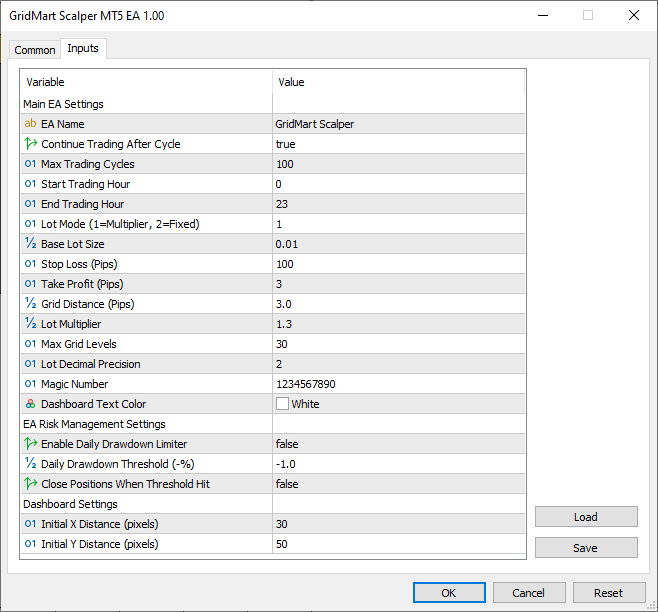
From the image, we can see that we can control the program from the defined user interface. We now need to continue to define some helper functions that we will use when needing basic and frequent actions like the currency pair or position type. Here is the logic we adapted for that.
//+------------------------------------------------------------------+ //| Retrieve the current account balance | //+------------------------------------------------------------------+ double GetAccountBalance() { //--- Return the current account balance return AccountInfoDouble(ACCOUNT_BALANCE); } //+------------------------------------------------------------------+ //| Retrieve the magic number of the selected position | //+------------------------------------------------------------------+ long GetPositionMagic() { //--- Return the magic number of the selected position return PositionGetInteger(POSITION_MAGIC); } //+------------------------------------------------------------------+ //| Retrieve the open price of the selected position | //+------------------------------------------------------------------+ double GetPositionOpenPrice() { //--- Return the open price of the selected position return PositionGetDouble(POSITION_PRICE_OPEN); } //+------------------------------------------------------------------+ //| Retrieve the stop-loss price of the selected position | //+------------------------------------------------------------------+ double GetPositionSL() { //--- Return the stop-loss price of the selected position return PositionGetDouble(POSITION_SL); } //+------------------------------------------------------------------+ //| Retrieve the take-profit price of the selected position | //+------------------------------------------------------------------+ double GetPositionTP() { //--- Return the take-profit price of the selected position return PositionGetDouble(POSITION_TP); } //+------------------------------------------------------------------+ //| Retrieve the symbol of the selected position | //+------------------------------------------------------------------+ string GetPositionSymbol() { //--- Return the symbol of the selected position return PositionGetString(POSITION_SYMBOL); } //+------------------------------------------------------------------+ //| Retrieve the ticket number of the selected position | //+------------------------------------------------------------------+ ulong GetPositionTicket() { //--- Return the ticket number of the selected position return PositionGetInteger(POSITION_TICKET); } //+------------------------------------------------------------------+ //| Retrieve the open time of the selected position | //+------------------------------------------------------------------+ datetime GetPositionOpenTime() { //--- Return the open time of the selected position as a datetime return (datetime)PositionGetInteger(POSITION_TIME); } //+------------------------------------------------------------------+ //| Retrieve the type of the selected position | //+------------------------------------------------------------------+ int GetPositionType() { //--- Return the type of the selected position (buy/sell) return (int)PositionGetInteger(POSITION_TYPE); }
We use the "GetAccountBalance" function with the AccountInfoDouble function to retrieve the current account balance, enabling balance tracking for risk management.
We implement the "GetPositionMagic" function using the PositionGetInteger function to fetch a position’s magic number, the "GetPositionOpenPrice" function with PositionGetDouble to obtain the open price, and the "GetPositionSL" and "GetPositionTP" functions with "PositionGetDouble" to access stop-loss and take-profit levels, respectively, supporting precise trade calculations.
Additionally, we define the "GetPositionSymbol" function with PositionGetString to verify a position’s symbol, the "GetPositionTicket" function and "GetPositionOpenTime" function with "PositionGetInteger" to track position identifiers and opening times, and the "GetPositionType" function to determine buy or sell status, facilitating accurate position monitoring and trade logic. We can now move on to creating the dashboard, and we will need helper functions to make the work easier.
//+------------------------------------------------------------------+ //| Create a rectangular object for the dashboard | //+------------------------------------------------------------------+ void CreateRectangle(string name, int x, int y, int width, int height, color bgColor, color borderColor) { //--- Check if object does not exist if (ObjectFind(0, name) < 0) { //--- Create a rectangle label object ObjectCreate(0, name, OBJ_RECTANGLE_LABEL, 0, 0, 0); } //--- Set X-coordinate ObjectSetInteger(0, name, OBJPROP_XDISTANCE, x); //--- Set Y-coordinate ObjectSetInteger(0, name, OBJPROP_YDISTANCE, y); //--- Set width ObjectSetInteger(0, name, OBJPROP_XSIZE, width); //--- Set height ObjectSetInteger(0, name, OBJPROP_YSIZE, height); //--- Set background color ObjectSetInteger(0, name, OBJPROP_BGCOLOR, bgColor); //--- Set border type to flat ObjectSetInteger(0, name, OBJPROP_BORDER_TYPE, BORDER_FLAT); //--- Set border color ObjectSetInteger(0, name, OBJPROP_COLOR, borderColor); //--- Set border width ObjectSetInteger(0, name, OBJPROP_WIDTH, 1); //--- Set object to foreground ObjectSetInteger(0, name, OBJPROP_BACK, false); //--- Disable object selection ObjectSetInteger(0, name, OBJPROP_SELECTABLE, false); //--- Hide object from object list ObjectSetInteger(0, name, OBJPROP_HIDDEN, true); } //+------------------------------------------------------------------+ //| Create a text label for the dashboard | //+------------------------------------------------------------------+ void CreateTextLabel(string name, int x, int y, string text, color clr, int fontSize, string font = "Arial") { //--- Check if object does not exist if (ObjectFind(0, name) < 0) { //--- Create a text label object ObjectCreate(0, name, OBJ_LABEL, 0, 0, 0); } //--- Set X-coordinate ObjectSetInteger(0, name, OBJPROP_XDISTANCE, x); //--- Set Y-coordinate ObjectSetInteger(0, name, OBJPROP_YDISTANCE, y); //--- Set label text ObjectSetString(0, name, OBJPROP_TEXT, text); //--- Set font ObjectSetString(0, name, OBJPROP_FONT, font); //--- Set font size ObjectSetInteger(0, name, OBJPROP_FONTSIZE, fontSize); //--- Set text color ObjectSetInteger(0, name, OBJPROP_COLOR, clr); //--- Set object to foreground ObjectSetInteger(0, name, OBJPROP_BACK, false); //--- Disable object selection ObjectSetInteger(0, name, OBJPROP_SELECTABLE, false); //--- Hide object from object list ObjectSetInteger(0, name, OBJPROP_HIDDEN, true); } //+------------------------------------------------------------------+ //| Create a button for the dashboard | //+------------------------------------------------------------------+ void CreateButton(string name, string text, int x, int y, int width, int height, color textColor, color bgColor, int fontSize, color borderColor, bool isBack, string font = "Arial") { //--- Check if object does not exist if (ObjectFind(0, name) < 0) { //--- Create a button object ObjectCreate(0, name, OBJ_BUTTON, 0, 0, 0); } //--- Set X-coordinate ObjectSetInteger(0, name, OBJPROP_XDISTANCE, x); //--- Set Y-coordinate ObjectSetInteger(0, name, OBJPROP_YDISTANCE, y); //--- Set width ObjectSetInteger(0, name, OBJPROP_XSIZE, width); //--- Set height ObjectSetInteger(0, name, OBJPROP_YSIZE, height); //--- Set button text ObjectSetString(0, name, OBJPROP_TEXT, text); //--- Set font ObjectSetString(0, name, OBJPROP_FONT, font); //--- Set font size ObjectSetInteger(0, name, OBJPROP_FONTSIZE, fontSize); //--- Set text color ObjectSetInteger(0, name, OBJPROP_COLOR, textColor); //--- Set background color ObjectSetInteger(0, name, OBJPROP_BGCOLOR, bgColor); //--- Set border color ObjectSetInteger(0, name, OBJPROP_BORDER_COLOR, borderColor); //--- Set background rendering ObjectSetInteger(0, name, OBJPROP_BACK, isBack); //--- Reset button state ObjectSetInteger(0, name, OBJPROP_STATE, false); //--- Disable button selection ObjectSetInteger(0, name, OBJPROP_SELECTABLE, false); //--- Hide button from object list ObjectSetInteger(0, name, OBJPROP_HIDDEN, true); }
Here, we define the "CreateRectangle" function with ObjectCreate and ObjectSetInteger functions to draw rectangular elements like the dashboard background and header, setting properties such as position, size, and colors for a polished layout. We implement the "CreateTextLabel" function, utilizing "ObjectCreate" and ObjectSetString to display metrics like spread and lot sizes, with customizable font and color settings for clear readability.
Additionally, we define the "CreateButton" function to add interactive buttons, such as the close button, enabling user actions with tailored styling and hover effects, ensuring a seamless and visually intuitive dashboard experience. We can now use these functions to create the dashboard elements in a new function but since we will need the total profit count, let's define the function for that.
//+------------------------------------------------------------------+ //| Calculate the total unrealized profit of open positions | //+------------------------------------------------------------------+ double CalculateTotalProfit() { //--- Initialize profit accumulator double profit = 0; //--- Iterate through open positions for (int i = PositionsTotal() - 1; i >= 0; i--) { //--- Get position ticket ulong ticket = PositionGetTicket(i); //--- Select position by ticket if (PositionSelectByTicket(ticket) && GetPositionSymbol() == _Symbol && GetPositionMagic() == MAGIC) { //--- Accumulate unrealized profit profit += PositionGetDouble(POSITION_PROFIT); } } //--- Return total profit return profit; }
Here, we implement the "CalculateTotalProfit" function with PositionsTotal and PositionGetTicket to iterate through open positions, selecting each via PositionSelectByTicket and verifying its symbol and magic number with "GetPositionSymbol" and "GetPositionMagic" to get total profit. We accumulate unrealized profits using the PositionGetDouble function to retrieve each position’s profit, storing the sum in the "profit" variable, which enables accurate monitoring of trading outcomes. We can then continue to compose the dashboard creation function as follows.
//+------------------------------------------------------------------+ //| Update the dashboard with real-time trading metrics | //+------------------------------------------------------------------+ void UpdateDashboard() { //--- Exit if dashboard is not visible if (!dashboardVisible) return; //--- Create dashboard background rectangle CreateRectangle("Dashboard", panelStartX, panelStartY, DASHBOARD_WIDTH, DASHBOARD_HEIGHT, BACKGROUND_COLOR, BORDER_COLOR); //--- Create header rectangle CreateRectangle("Header", panelStartX, panelStartY, DASHBOARD_WIDTH, HEADER_HEIGHT, headerHovered ? HEADER_HOVER_COLOR : HEADER_NORMAL_COLOR, BORDER_COLOR); //--- Create header text label CreateTextLabel("HeaderText", panelStartX + 10, panelStartY + 8, EA_NAME, clrBlack, FONT_SIZE_HEADER, "Arial Bold"); //--- Create close button CreateButton("CloseButton", CharToString(122), panelStartX + DASHBOARD_WIDTH - CLOSE_BUTTON_WIDTH, panelStartY + 1, CLOSE_BUTTON_WIDTH, CLOSE_BUTTON_HEIGHT, clrWhite, closeButtonHovered ? CLOSE_BUTTON_HOVER_BG : CLOSE_BUTTON_NORMAL_BG, FONT_SIZE_BUTTON, closeButtonHovered ? CLOSE_BUTTON_HOVER_BORDER : CLOSE_BUTTON_NORMAL_BORDER, false, "Wingdings"); //--- Initialize dashboard content layout //--- Set initial Y-position below header int sectionY = panelStartY + HEADER_HEIGHT + 15; //--- Set left column X-position for labels int labelXLeft = panelStartX + 15; //--- Set right column X-position for values int valueXRight = panelStartX + 160; //--- Set row height for metrics int rowHeight = 15; //--- Pre-calculate values for conditional coloring //--- Calculate total unrealized profit double profit = CalculateTotalProfit(); //--- Set profit color based on value color profitColor = (profit > 0) ? VALUE_POSITIVE_COLOR : (profit < 0) ? VALUE_LOSS_COLOR : TEXT_COLOR; //--- Get current equity double equity = AccountInfoDouble(ACCOUNT_EQUITY); //--- Get current balance double balance = AccountInfoDouble(ACCOUNT_BALANCE); //--- Set equity color based on comparison with balance color equityColor = (equity > balance) ? VALUE_POSITIVE_COLOR : (equity < balance) ? VALUE_NEGATIVE_COLOR : TEXT_COLOR; //--- Set balance color based on comparison with daily balance color balanceColor = (balance > dailyBalance) ? VALUE_POSITIVE_COLOR : (balance < dailyBalance) ? VALUE_NEGATIVE_COLOR : TEXT_COLOR; //--- Set open orders color based on active orders color ordersColor = (activeOrders > 0) ? VALUE_ACTIVE_COLOR : TEXT_COLOR; //--- Set drawdown active color based on trading state color drawdownColor = tradingEnabled ? VALUE_DRAWDOWN_INACTIVE : VALUE_DRAWDOWN_ACTIVE; //--- Set lot sizes color based on active orders color lotsColor = (activeOrders > 0) ? VALUE_ACTIVE_COLOR : TEXT_COLOR; //--- Calculate dynamic spread and color //--- Get current ask price double ask = SymbolInfoDouble(_Symbol, SYMBOL_ASK); //--- Get current bid price double bid = SymbolInfoDouble(_Symbol, SYMBOL_BID); //--- Calculate spread in points double spread = (ask - bid) / Point(); //--- Format spread with 1 decimal place for display string spreadDisplay = DoubleToString(spread, 1); //--- Initialize spread color color spreadColor; //--- Check if spread is low (favorable) if (spread <= 2.0) { //--- Set color to lime green for low spread spreadColor = VALUE_POSITIVE_COLOR; } //--- Check if spread is medium (moderate) else if (spread <= 5.0) { //--- Set color to gold for medium spread spreadColor = VALUE_ACTIVE_COLOR; } //--- Spread is high (costly) else { //--- Set color to orange for high spread spreadColor = VALUE_NEGATIVE_COLOR; } //--- Account Information Section //--- Create section title CreateTextLabel("SectionAccount", labelXLeft, sectionY, "Account Information", SECTION_TITLE_COLOR, FONT_SIZE_SECTION_TITLE, "Arial Bold"); //--- Move to next row sectionY += rowHeight + 5; //--- Create account number label CreateTextLabel("AccountNumberLabel", labelXLeft, sectionY, "Account:", TEXT_COLOR, FONT_SIZE_METRIC); //--- Create account number value CreateTextLabel("AccountNumberValue", valueXRight, sectionY, DoubleToString(AccountInfoInteger(ACCOUNT_LOGIN), 0), TEXT_COLOR, FONT_SIZE_METRIC); //--- Move to next row sectionY += rowHeight; //--- Create account name label CreateTextLabel("AccountNameLabel", labelXLeft, sectionY, "Name:", TEXT_COLOR, FONT_SIZE_METRIC); //--- Create account name value CreateTextLabel("AccountNameValue", valueXRight, sectionY, AccountInfoString(ACCOUNT_NAME), TEXT_COLOR, FONT_SIZE_METRIC); //--- Move to next row sectionY += rowHeight; //--- Create leverage label CreateTextLabel("LeverageLabel", labelXLeft, sectionY, "Leverage:", TEXT_COLOR, FONT_SIZE_METRIC); //--- Create leverage value CreateTextLabel("LeverageValue", valueXRight, sectionY, "1:" + DoubleToString(AccountInfoInteger(ACCOUNT_LEVERAGE), 0), TEXT_COLOR, FONT_SIZE_METRIC); //--- Move to next row sectionY += rowHeight; //--- Market Information Section //--- Create section title CreateTextLabel("SectionMarket", labelXLeft, sectionY, "Market Information", SECTION_TITLE_COLOR, FONT_SIZE_SECTION_TITLE, "Arial Bold"); //--- Move to next row sectionY += rowHeight + 5; //--- Create spread label CreateTextLabel("SpreadLabel", labelXLeft, sectionY, "Spread:", TEXT_COLOR, FONT_SIZE_METRIC); //--- Create spread value with dynamic color CreateTextLabel("SpreadValue", valueXRight, sectionY, spreadDisplay, spreadColor, FONT_SIZE_METRIC); //--- Move to next row sectionY += rowHeight; //--- Trading Statistics Section //--- Create section title CreateTextLabel("SectionTrading", labelXLeft, sectionY, "Trading Statistics", SECTION_TITLE_COLOR, FONT_SIZE_SECTION_TITLE, "Arial Bold"); //--- Move to next row sectionY += rowHeight + 5; //--- Create balance label CreateTextLabel("BalanceLabel", labelXLeft, sectionY, "Balance:", TEXT_COLOR, FONT_SIZE_METRIC); //--- Create balance value with dynamic color CreateTextLabel("BalanceValue", valueXRight, sectionY, DoubleToString(balance, 2), balanceColor, FONT_SIZE_METRIC); //--- Move to next row sectionY += rowHeight; //--- Create equity label CreateTextLabel("EquityLabel", labelXLeft, sectionY, "Equity:", TEXT_COLOR, FONT_SIZE_METRIC); //--- Create equity value with dynamic color CreateTextLabel("EquityValue", valueXRight, sectionY, DoubleToString(equity, 2), equityColor, FONT_SIZE_METRIC); //--- Move to next row sectionY += rowHeight; //--- Create profit label CreateTextLabel("ProfitLabel", labelXLeft, sectionY, "Profit:", TEXT_COLOR, FONT_SIZE_METRIC); //--- Create profit value with dynamic color CreateTextLabel("ProfitValue", valueXRight, sectionY, DoubleToString(profit, 2), profitColor, FONT_SIZE_METRIC); //--- Move to next row sectionY += rowHeight; //--- Create open orders label CreateTextLabel("OrdersLabel", labelXLeft, sectionY, "Open Orders:", TEXT_COLOR, FONT_SIZE_METRIC); //--- Create open orders value with dynamic color CreateTextLabel("OrdersValue", valueXRight, sectionY, IntegerToString(activeOrders), ordersColor, FONT_SIZE_METRIC); //--- Move to next row sectionY += rowHeight; //--- Create drawdown active label CreateTextLabel("DrawdownLabel", labelXLeft, sectionY, "Drawdown Active:", TEXT_COLOR, FONT_SIZE_METRIC); //--- Create drawdown active value with dynamic color CreateTextLabel("DrawdownValue", valueXRight, sectionY, tradingEnabled ? "No" : "Yes", drawdownColor, FONT_SIZE_METRIC); //--- Move to next row sectionY += rowHeight; //--- Active Lot Sizes //--- Create active lots label CreateTextLabel("ActiveLotsLabel", labelXLeft, sectionY, "Active Lots:", TEXT_COLOR, FONT_SIZE_METRIC); //--- Create active lots value with dynamic color CreateTextLabel("ActiveLotsValue", valueXRight, sectionY, GetActiveLotSizes(), lotsColor, FONT_SIZE_METRIC); //--- Redraw the chart to update display ChartRedraw(0); }
Here, we define the "UpdateDashboard" function to render a dynamic dashboard for real-time trading metrics, providing a comprehensive interface for monitoring performance. We start by checking the "dashboardVisible" variable to ensure updates occur only when the dashboard is active, preventing unnecessary processing. We use the "CreateRectangle" function to draw the main dashboard panel and header, setting dimensions with "DASHBOARD_WIDTH" and "HEADER_HEIGHT", and applying colors like "BACKGROUND_COLOR" and "HEADER_NORMAL_COLOR" or "HEADER_HOVER_COLOR" based on the "headerHovered" state for visual feedback.
We employ the "CreateTextLabel" function to display critical metrics, including account balance, equity, profit, spread, open orders, drawdown status, and active lot sizes, organizing them into sections like Account Information, Market Information, and Trading Statistics. We calculate the spread using the SymbolInfoDouble function to retrieve ask and bid prices, applying conditional color-coding with "VALUE_POSITIVE_COLOR" for low spreads (≤ 2.0 points), "VALUE_ACTIVE_COLOR" for medium spreads (2.1–5.0 points), and "VALUE_NEGATIVE_COLOR" for high spreads (> 5.0 points). You can change this to your preferred ranges. We then use AccountInfoDouble to fetch balance and equity, and "CalculateTotalProfit" to determine unrealized profit, assigning colors like "profitColor" based on profit value for intuitive monitoring.
We integrate the "CreateButton" function to add an interactive close button, styled with "CLOSE_BUTTON_WIDTH", "FONT_SIZE_BUTTON", and dynamic colors ("CLOSE_BUTTON_NORMAL_BG" or "CLOSE_BUTTON_HOVER_BG") based on "closeButtonHovered", enhancing user interaction. We call the "GetActiveLotSizes" function to display up to three lot sizes in ascending order, using "lotsColor" for visual distinction, and we manage layout with variables like "sectionY", "labelXLeft", and "valueXRight" for precise positioning. We finalize updates with the ChartRedraw function to ensure smooth rendering. We can now call this function on the OnInit event handler to create the first display.
//+------------------------------------------------------------------+ //| Expert initialization function | //+------------------------------------------------------------------+ int OnInit() { //--- Calculate pip value based on symbol digits (3 or 5 digits: multiply by 10) pipValue = (_Digits == 3 || _Digits == 5) ? 10.0 * Point() : Point(); //--- Set the magic number for trade operations obj_Trade.SetExpertMagicNumber(MAGIC); //--- Initialize dashboard visibility dashboardVisible = true; //--- Set initial X-coordinate of the dashboard panelStartX = PANEL_X; //--- Set initial Y-coordinate of the dashboard panelStartY = PANEL_Y; //--- Initialize the dashboard display UpdateDashboard(); //--- Enable mouse move events for dragging and hovering ChartSetInteger(0, CHART_EVENT_MOUSE_MOVE, true); //--- Return successful initialization return INIT_SUCCEEDED; }
On the OnInit event handler, we calculate "pipValue" with the Point function, set "obj_Trade" with "SetExpertMagicNumber" for "MAGIC", and enable "dashboardVisible". We position the dashboard using "panelStartX" and "panelStartY" with "PANEL_X" and "PANEL_Y", call the "UpdateDashboard" function to display it, and use ChartSetInteger for mouse interactions, returning INIT_SUCCEEDED. On the OnDeInit event handler, we make sure to delete the created objects as follows.
//+------------------------------------------------------------------+ //| Expert deinitialization function | //+------------------------------------------------------------------+ void OnDeinit(const int reason) { //--- Remove all graphical objects from the chart ObjectsDeleteAll(0); //--- Disable mouse move events ChartSetInteger(0, CHART_EVENT_MOUSE_MOVE, false); }
We simply use the ObjectsDeleteAll function to delete all the chart objects since we don't need them any longer. Upon compilation, here is the outcome.
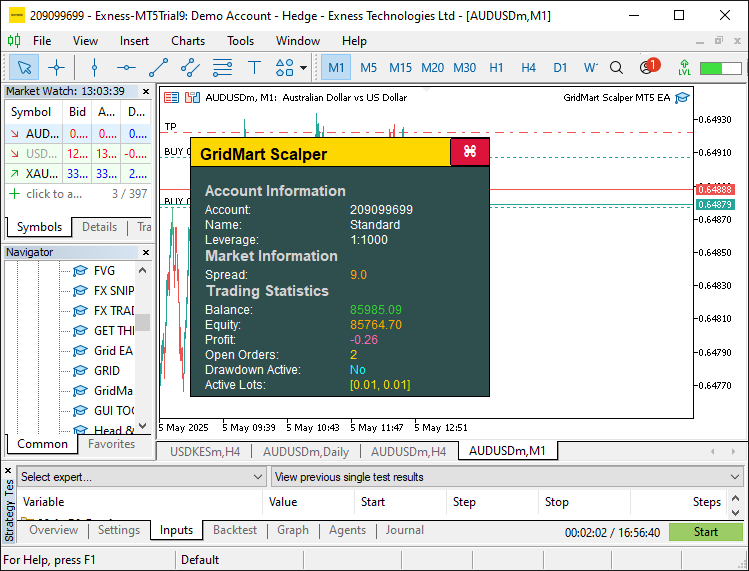
To make the panel intractable, we call the OnChartEvent event handler to handle hover and dragging effects. Here is the logic we implement to make that work.
//+------------------------------------------------------------------+ //| Expert chart event handler | //+------------------------------------------------------------------+ void OnChartEvent(const int id, const long &lparam, const double &dparam, const string &sparam) { //--- Exit if dashboard is not visible if (!dashboardVisible) return; //--- Handle mouse click events if (id == CHARTEVENT_CLICK) { //--- Get X-coordinate of the click int x = (int)lparam; //--- Get Y-coordinate of the click int y = (int)dparam; //--- Calculate close button X-position int buttonX = panelStartX + DASHBOARD_WIDTH - CLOSE_BUTTON_WIDTH - 5; //--- Calculate close button Y-position int buttonY = panelStartY + 1; //--- Check if click is within close button bounds if (x >= buttonX && x <= buttonX + CLOSE_BUTTON_WIDTH && y >= buttonY && y <= buttonY + CLOSE_BUTTON_HEIGHT) { //--- Hide the dashboard dashboardVisible = false; //--- Remove all graphical objects ObjectsDeleteAll(0); //--- Redraw the chart ChartRedraw(0); } } //--- Handle mouse move events if (id == CHARTEVENT_MOUSE_MOVE) { //--- Get X-coordinate of the mouse int mouseX = (int)lparam; //--- Get Y-coordinate of the mouse int mouseY = (int)dparam; //--- Get mouse state (e.g., button pressed) int mouseState = (int)sparam; //--- Update close button hover state //--- Calculate close button X-position int buttonX = panelStartX + DASHBOARD_WIDTH - CLOSE_BUTTON_WIDTH - 5; //--- Calculate close button Y-position int buttonY = panelStartY + 1; //--- Check if mouse is over the close button bool isCloseHovered = (mouseX >= buttonX && mouseX <= buttonX + CLOSE_BUTTON_WIDTH && mouseY >= buttonY && mouseY <= buttonY + CLOSE_BUTTON_HEIGHT); //--- Update close button hover state if changed if (isCloseHovered != closeButtonHovered) { //--- Set new hover state closeButtonHovered = isCloseHovered; //--- Update close button background color ObjectSetInteger(0, "CloseButton", OBJPROP_BGCOLOR, isCloseHovered ? CLOSE_BUTTON_HOVER_BG : CLOSE_BUTTON_NORMAL_BG); //--- Update close button border color ObjectSetInteger(0, "CloseButton", OBJPROP_BORDER_COLOR, isCloseHovered ? CLOSE_BUTTON_HOVER_BORDER : CLOSE_BUTTON_NORMAL_BORDER); //--- Redraw the chart ChartRedraw(0); } //--- Update header hover state //--- Set header X-position int headerX = panelStartX; //--- Set header Y-position int headerY = panelStartY; //--- Check if mouse is over the header bool isHeaderHovered = (mouseX >= headerX && mouseX <= headerX + DASHBOARD_WIDTH && mouseY >= headerY && mouseY <= headerY + HEADER_HEIGHT); //--- Update header hover state if changed if (isHeaderHovered != headerHovered) { //--- Set new hover state headerHovered = isHeaderHovered; //--- Update header background color ObjectSetInteger(0, "Header", OBJPROP_BGCOLOR, isHeaderHovered ? HEADER_HOVER_COLOR : HEADER_NORMAL_COLOR); //--- Redraw the chart ChartRedraw(0); } //--- Handle panel dragging //--- Store previous mouse state for click detection static int prevMouseState = 0; //--- Check for mouse button press (start dragging) if (prevMouseState == 0 && mouseState == 1) { //--- Check if header is hovered to initiate dragging if (isHeaderHovered) { //--- Enable dragging mode panelDragging = true; //--- Store initial mouse X-coordinate panelDragX = mouseX; //--- Store initial mouse Y-coordinate panelDragY = mouseY; //--- Get current dashboard X-position panelStartX = (int)ObjectGetInteger(0, "Dashboard", OBJPROP_XDISTANCE); //--- Get current dashboard Y-position panelStartY = (int)ObjectGetInteger(0, "Dashboard", OBJPROP_YDISTANCE); //--- Disable chart scrolling during dragging ChartSetInteger(0, CHART_MOUSE_SCROLL, false); } } //--- Update dashboard position during dragging if (panelDragging && mouseState == 1) { //--- Calculate X movement delta int dx = mouseX - panelDragX; //--- Calculate Y movement delta int dy = mouseY - panelDragY; //--- Update dashboard X-position panelStartX += dx; //--- Update dashboard Y-position panelStartY += dy; //--- Refresh the dashboard with new position UpdateDashboard(); //--- Update stored mouse X-coordinate panelDragX = mouseX; //--- Update stored mouse Y-coordinate panelDragY = mouseY; //--- Redraw the chart ChartRedraw(0); } //--- Stop dragging when mouse button is released if (mouseState == 0) { //--- Check if dragging is active if (panelDragging) { //--- Disable dragging mode panelDragging = false; //--- Re-enable chart scrolling ChartSetInteger(0, CHART_MOUSE_SCROLL, true); } } //--- Update previous mouse state prevMouseState = mouseState; } }
On the OnChartEvent event handler, we begin by checking the "dashboardVisible" variable to ensure event processing occurs only when the dashboard is active, optimizing performance by skipping unnecessary updates. For mouse click events, we calculate the close button’s position using "panelStartX", "DASHBOARD_WIDTH", "CLOSE_BUTTON_WIDTH", and "panelStartY", and if a click falls within its bounds, we set "dashboardVisible" to false, call the ObjectsDeleteAll function to remove all graphical objects, and use the ChartRedraw function to refresh the chart, effectively hiding the dashboard.
For mouse move events, we track the cursor’s position with "mouseX" and "mouseY", and monitor "mouseState" to detect actions like clicks or releases. We update the close button’s hover state by comparing "mouseX" and "mouseY" against its coordinates, setting "closeButtonHovered" and using the ObjectSetInteger function to adjust OBJPROP_BGCOLOR and "OBJPROP_BORDER_COLOR" to "CLOSE_BUTTON_HOVER_BG" or "CLOSE_BUTTON_NORMAL_BG" for visual feedback. Similarly, we manage the header’s hover state with "headerHovered", applying "HEADER_HOVER_COLOR" or "HEADER_NORMAL_COLOR" via "ObjectSetInteger" to enhance interactivity.
To enable dashboard dragging, we use a static "prevMouseState" to detect mouse button presses, initiating drag mode with "panelDragging" when the header is hovered, and store initial coordinates in "panelDragX" and "panelDragY". We retrieve the dashboard’s current position with the ObjectGetInteger function for "OBJPROP_XDISTANCE" and OBJPROP_YDISTANCE, disable chart scrolling using the ChartSetInteger function, and update "panelStartX" and "panelStartY" based on mouse movement deltas, calling the "UpdateDashboard" function to reposition the dashboard in real-time. When the mouse button is released, we reset "panelDragging" and re-enable scrolling with "ChartSetInteger", finalizing each update with ChartRedraw to ensure a seamless user experience. Upon compilation, here is the outcome.
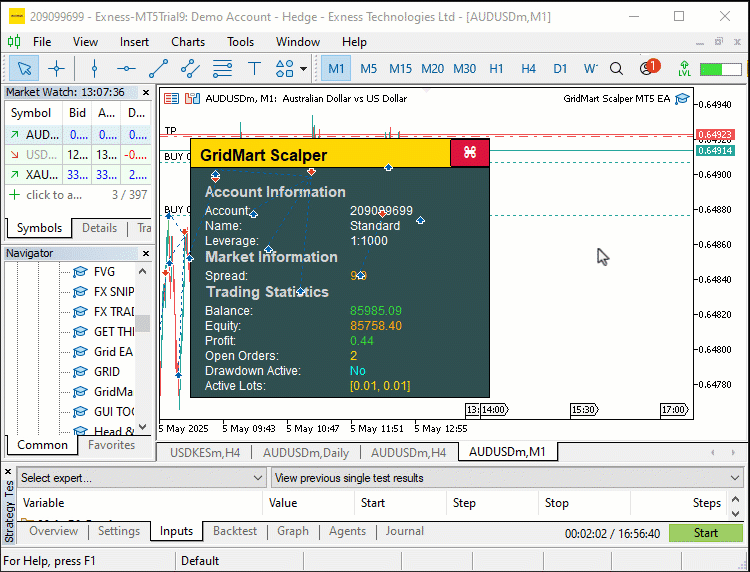
From the visualization, we can see that we can drag, and hover over the buttons, update the metrics, and close the entire dashboard. We can now move on to the critical part which is opening and managing the positions, and the dashboard will ease the work by visualizing the progress dynamically. To achieve this, we will need some helper functions to calculate the lot sizes and more as below.
//+------------------------------------------------------------------+ //| Calculate the lot size for a new trade | //+------------------------------------------------------------------+ double CalculateLotSize(ENUM_POSITION_TYPE tradeType) { //--- Initialize lot size double lotSize = 0; //--- Select lot size calculation mode switch (LOT_MODE) { //--- Fixed lot size mode case 0: //--- Use base lot size lotSize = BASE_LOT; break; //--- Multiplier-based lot size mode case 1: //--- Calculate lot size with multiplier based on active orders lotSize = NormalizeDouble(BASE_LOT * MathPow(LOT_MULTIPLIER, activeOrders), LOT_PRECISION); break; //--- Fixed lot size with multiplier on loss mode case 2: { //--- Initialize last close time datetime lastClose = 0; //--- Set default lot size lotSize = BASE_LOT; //--- Select trade history for the last 24 hours HistorySelect(TimeCurrent() - 24 * 60 * 60, TimeCurrent()); //--- Iterate through trade history for (int i = HistoryDealsTotal() - 1; i >= 0; i--) { //--- Get deal ticket ulong ticket = HistoryDealGetTicket(i); //--- Select deal by ticket if (HistoryDealSelect(ticket) && HistoryDealGetInteger(ticket, DEAL_ENTRY) == DEAL_ENTRY_OUT && HistoryDealGetString(ticket, DEAL_SYMBOL) == _Symbol && HistoryDealGetInteger(ticket, DEAL_MAGIC) == MAGIC) { //--- Check if deal is more recent if (lastClose < HistoryDealGetInteger(ticket, DEAL_TIME)) { //--- Update last close time lastClose = (int)HistoryDealGetInteger(ticket, DEAL_TIME); //--- Check if deal resulted in a loss if (HistoryDealGetDouble(ticket, DEAL_PROFIT) < 0) { //--- Increase lot size by multiplier lotSize = NormalizeDouble(HistoryDealGetDouble(ticket, DEAL_VOLUME) * LOT_MULTIPLIER, LOT_PRECISION); } else { //--- Reset to base lot size lotSize = BASE_LOT; } } } } break; } } //--- Return calculated lot size return lotSize; } //+------------------------------------------------------------------+ //| Count the number of active orders | //+------------------------------------------------------------------+ int CountActiveOrders() { //--- Initialize order counter int count = 0; //--- Iterate through open positions for (int i = PositionsTotal() - 1; i >= 0; i--) { //--- Get position ticket ulong ticket = PositionGetTicket(i); //--- Select position by ticket if (PositionSelectByTicket(ticket) && GetPositionSymbol() == _Symbol && GetPositionMagic() == MAGIC) { //--- Check if position is buy or sell if (GetPositionType() == POSITION_TYPE_BUY || GetPositionType() == POSITION_TYPE_SELL) { //--- Increment order counter count++; } } } //--- Return total active orders return count; } //+------------------------------------------------------------------+ //| Return a formatted string of active lot sizes in ascending order | //+------------------------------------------------------------------+ string GetActiveLotSizes() { //--- Check if no active orders if (activeOrders == 0) { //--- Return waiting message return "[Waiting]"; } //--- Initialize array for lot sizes double lotSizes[]; //--- Resize array to match active orders ArrayResize(lotSizes, activeOrders); //--- Initialize counter int count = 0; //--- Iterate through open positions for (int i = PositionsTotal() - 1; i >= 0 && count < activeOrders; i--) { //--- Get position ticket ulong ticket = PositionGetTicket(i); //--- Select position by ticket if (PositionSelectByTicket(ticket) && GetPositionSymbol() == _Symbol && GetPositionMagic() == MAGIC) { //--- Store position volume (lot size) lotSizes[count] = PositionGetDouble(POSITION_VOLUME); //--- Increment counter count++; } } //--- Sort lot sizes in ascending order ArraySort(lotSizes); //--- Initialize result string string result = ""; //--- Determine maximum number of lots to display (up to 3) int maxDisplay = (activeOrders > 3) ? 3 : activeOrders; //--- Format lot sizes for (int i = 0; i < maxDisplay; i++) { //--- Add comma and space for subsequent entries if (i > 0) result += ", "; //--- Convert lot size to string with specified precision result += DoubleToString(lotSizes[i], LOT_PRECISION); } //--- Append ellipsis if more than 3 orders if (activeOrders > 3) result += ", ..."; //--- Return formatted lot sizes in brackets return "[" + result + "]"; }
Here, we define the "CalculateLotSize", "CountActiveOrders", and "GetActiveLotSizes" functions to help in trade sizing, position tracking, and dashboard updates, ensuring precise execution and comprehensive real-time monitoring.
We implement the "CalculateLotSize" function to determine trade volumes based on the "LOT_MODE" input, supporting three modes: fixed lot sizing by returning "BASE_LOT" directly, Martingale scaling by applying the MathPow function with "LOT_MULTIPLIER" and "activeOrders" to increase lots exponentially, or loss-based adjustments where we use the HistorySelect function to review the last 24 hours of trades.
In the loss-based mode, we iterate with HistoryDealsTotal, retrieve deal details via HistoryDealGetTicket and HistoryDealGetDouble, and adjust "lotSize" with NormalizeDouble if the most recent trade was a loss, resetting to "BASE_LOT" otherwise, ensuring precise lot calculations tailored to trading outcomes.
We utilize the "CountActiveOrders" function to maintain an accurate count of open positions, critical for Martingale scaling and dashboard accuracy. We iterate through all positions using the PositionsTotal function, select each with PositionGetTicket, and verify relevance with the "GetPositionSymbol" and "GetPositionMagic" functions, incrementing the "count" variable for buy or sell positions identified by "GetPositionType", thus updating "activeOrders" reliably.
Additionally, we craft the "GetActiveLotSizes" function to format and display lot sizes on the dashboard, enhancing user visibility into active trades. We check "activeOrders" to return "[Waiting]" if none exist, otherwise initialize an array with ArrayResize to store lot sizes. We iterate positions with PositionsTotal, select them via "PositionGetTicket", and use PositionGetDouble to collect volumes in "lotSizes", sorting them in ascending order with the ArraySort function. We format up to three lots using DoubleToString with "LOT_PRECISION", adding commas and an ellipsis for more than three orders, and return the result in brackets, providing a clear, professional display of trade volumes for real-time monitoring. Still, we need to define functions to help in order placement as below.
//+------------------------------------------------------------------+ //| Place a new trade order | //+------------------------------------------------------------------+ int PlaceOrder(ENUM_ORDER_TYPE orderType, double lot, double price, double slPrice, int gridLevel) { //--- Calculate stop-loss price double sl = CalculateSL(slPrice, STOP_LOSS_PIPS); //--- Calculate take-profit price double tp = CalculateTP(price, TAKE_PROFIT_PIPS, orderType); //--- Initialize ticket number int ticket = 0; //--- Set maximum retry attempts int retries = 100; //--- Create trade comment with grid level string comment = "GridMart Scalper-" + IntegerToString(gridLevel); //--- Attempt to place order with retries for (int i = 0; i < retries; i++) { //--- Open position with specified parameters ticket = obj_Trade.PositionOpen(_Symbol, orderType, lot, price, sl, tp, comment); //--- Get last error code int error = GetLastError(); //--- Exit loop if order is successful if (error == 0) break; //--- Check for retryable errors (server busy, trade context busy, etc.) if (!(error == 4 || error == 137 || error == 146 || error == 136)) break; //--- Wait before retrying Sleep(5000); } //--- Return order ticket (or error code if negative) return ticket; } //+------------------------------------------------------------------+ //| Calculate the stop-loss price for a trade | //+------------------------------------------------------------------+ double CalculateSL(double price, int points) { //--- Check if stop-loss is disabled if (points == 0) return 0; //--- Calculate stop-loss price (subtract points from price) return price - points * pipValue; } //+------------------------------------------------------------------+ //| Calculate the take-profit price for a trade | //+------------------------------------------------------------------+ double CalculateTP(double price, int points, ENUM_ORDER_TYPE orderType) { //--- Check if take-profit is disabled if (points == 0) return 0; //--- Calculate take-profit for buy order (add points) if (orderType == ORDER_TYPE_BUY) return price + points * pipValue; //--- Calculate take-profit for sell order (subtract points) return price - points * pipValue; } //+------------------------------------------------------------------+ //| Retrieve the latest buy order price | //+------------------------------------------------------------------+ double GetLatestBuyPrice() { //--- Initialize price double price = 0; //--- Initialize latest ticket int latestTicket = 0; //--- Iterate through open positions for (int i = PositionsTotal() - 1; i >= 0; i--) { //--- Get position ticket ulong ticket = PositionGetTicket(i); //--- Select position by ticket if (PositionSelectByTicket(ticket) && GetPositionSymbol() == _Symbol && GetPositionMagic() == MAGIC && GetPositionType() == POSITION_TYPE_BUY) { //--- Check if ticket is more recent if ((int)ticket > latestTicket) { //--- Update price price = GetPositionOpenPrice(); //--- Update latest ticket latestTicket = (int)ticket; } } } //--- Return latest buy price return price; } //+------------------------------------------------------------------+ //| Retrieve the latest sell order price | //+------------------------------------------------------------------+ double GetLatestSellPrice() { //--- Initialize price double price = 0; //--- Initialize latest ticket int latestTicket = 0; //--- Iterate through open positions for (int i = PositionsTotal() - 1; i >= 0; i--) { //--- Get position ticket ulong ticket = PositionGetTicket(i); //--- Select position by ticket if (PositionSelectByTicket(ticket) && GetPositionSymbol() == _Symbol && GetPositionMagic() == MAGIC && GetPositionType() == POSITION_TYPE_SELL) { //--- Check if ticket is more recent if ((int)ticket > latestTicket) { //--- Update price price = GetPositionOpenPrice(); //--- Update latest ticket latestTicket = (int)ticket; } } } //--- Return latest sell price return price; } //+------------------------------------------------------------------+ //| Check if trading is allowed | //+------------------------------------------------------------------+ int IsTradingAllowed() { //--- Always allow trading return 1; }
Here, we implement the "PlaceOrder" function to initiate trades, using the "PositionOpen" function from "obj_Trade" to open positions with parameters like "lot", "price", and a comment formatted with IntegerToString for "gridLevel", incorporating retry logic with GetLastError and Sleep for robust execution. We utilize the "CalculateSL" function to compute stop-loss prices by subtracting "STOP_LOSS_PIPS" multiplied by "pipValue" from "slPrice", and the "CalculateTP" function to set take-profit levels, adding or subtracting "TAKE_PROFIT_PIPS" based on "orderType" for buy or sell trades, respectively.
We craft the "GetLatestBuyPrice" function to identify the most recent buy position’s price, iterating with PositionsTotal, selecting positions via PositionGetTicket, and verifying with "GetPositionSymbol", "GetPositionMagic", and "GetPositionType", updating "price" using "GetPositionOpenPrice" for the highest "ticket".
Similarly, we implement the "GetLatestSellPrice" function to retrieve the latest sell position’s price, following the same logic to ensure accurate grid placement. We define the "IsTradingAllowed" function to return a constant value of 1, enabling continuous trading without restrictions, which supports the strategy’s high-frequency approach. We can now use these functions to define the actual trading logic in the OnTick event handler.
//+------------------------------------------------------------------+ //| Expert tick function | //+------------------------------------------------------------------+ void OnTick() { //--- Get current ask price double ask = NormalizeDouble(SymbolInfoDouble(_Symbol, SYMBOL_ASK), _Digits); //--- Get current bid price double bid = NormalizeDouble(SymbolInfoDouble(_Symbol, SYMBOL_BID), _Digits); //--- Update dashboard if visible if (dashboardVisible) UpdateDashboard(); //--- Check if trading is allowed if (IsTradingAllowed()) { //--- Get current bar time datetime currentBarTime = iTime(_Symbol, _Period, 0); //--- Exit if the bar hasn’t changed if (lastBarTime == currentBarTime) return; //--- Update last bar time lastBarTime = currentBarTime; //--- Count active orders activeOrders = CountActiveOrders(); //--- Reset SL/TP update flag if no active orders if (activeOrders == 0) updateSLTP = false; //--- Reset position flags hasBuyPosition = false; hasSellPosition = false; //--- Iterate through open positions for (int i = PositionsTotal() - 1; i >= 0; i--) { //--- Get position ticket ulong ticket = PositionGetTicket(i); //--- Select position by ticket if (PositionSelectByTicket(ticket) && GetPositionSymbol() == _Symbol && GetPositionMagic() == MAGIC) { //--- Check for buy position if (GetPositionType() == POSITION_TYPE_BUY) { //--- Set buy position flag hasBuyPosition = true; //--- Clear sell position flag hasSellPosition = false; //--- Exit loop after finding a position break; } //--- Check for sell position else if (GetPositionType() == POSITION_TYPE_SELL) { //--- Set sell position flag hasSellPosition = true; //--- Clear buy position flag hasBuyPosition = false; //--- Exit loop after finding a position break; } } } //--- Check conditions to open new trades if (activeOrders > 0 && activeOrders <= MAX_GRID_LEVELS) { //--- Get latest buy price latestBuyPrice = GetLatestBuyPrice(); //--- Get latest sell price latestSellPrice = GetLatestSellPrice(); //--- Check if a new buy trade is needed if (hasBuyPosition && latestBuyPrice - ask >= GRID_DISTANCE * pipValue) openNewTrade = true; //--- Check if a new sell trade is needed if (hasSellPosition && bid - latestSellPrice >= GRID_DISTANCE * pipValue) openNewTrade = true; } //--- Allow new trades if no active orders if (activeOrders < 1) { //--- Clear position flags hasBuyPosition = false; hasSellPosition = false; //--- Signal to open a new trade openNewTrade = true; } //--- Execute new trade if signaled if (openNewTrade) { //--- Update latest buy price latestBuyPrice = GetLatestBuyPrice(); //--- Update latest sell price latestSellPrice = GetLatestSellPrice(); //--- Handle sell position if (hasSellPosition) { //--- Calculate lot size for sell order calculatedLot = CalculateLotSize(POSITION_TYPE_SELL); //--- Check if lot size is valid and trading is enabled if (calculatedLot > 0 && tradingEnabled) { //--- Place sell order int ticket = PlaceOrder(ORDER_TYPE_SELL, calculatedLot, bid, ask, activeOrders); //--- Check for order placement errors if (ticket < 0) { //--- Log error message Print("Sell Order Error: ", GetLastError()); return; } //--- Update latest sell price latestSellPrice = GetLatestSellPrice(); //--- Clear new trade signal openNewTrade = false; //--- Signal to modify positions modifyPositions = true; } } //--- Handle buy position else if (hasBuyPosition) { //--- Calculate lot size for buy order calculatedLot = CalculateLotSize(POSITION_TYPE_BUY); //--- Check if lot size is valid and trading is enabled if (calculatedLot > 0 && tradingEnabled) { //--- Place buy order int ticket = PlaceOrder(ORDER_TYPE_BUY, calculatedLot, ask, bid, activeOrders); //--- Check for order placement errors if (ticket < 0) { //--- Log error message Print("Buy Order Error: ", GetLastError()); return; } //--- Update latest buy price latestBuyPrice = GetLatestBuyPrice(); //--- Clear new trade signal openNewTrade = false; //--- Signal to modify positions modifyPositions = true; } } //--- } } }
We define the OnTick event handler to drive the core trading logic of the program, orchestrating real-time trade execution and position management. We begin by retrieving current market prices with the SymbolInfoDouble function to capture "ask" and "bid" values, normalized via NormalizeDouble, and update the dashboard using the "UpdateDashboard" function if "dashboardVisible" is true. We check trading permissions with the "IsTradingAllowed" function, ensuring trades proceed only when conditions allow, and use the iTime function to fetch the current bar’s timestamp, storing it in "currentBarTime" to prevent redundant processing by comparing with "lastBarTime".
We manage position tracking by calling the "CountActiveOrders" function to update "activeOrders", resetting "updateSLTP" if no orders exist, and iterating positions with PositionsTotal and PositionGetTicket to set "hasBuyPosition" or "hasSellPosition" based on "GetPositionType".
We evaluate grid conditions using "GetLatestBuyPrice" and "GetLatestSellPrice", triggering "openNewTrade" when price movements exceed "GRID_DISTANCE" times "pipValue" or if "activeOrders" is below "MAX_GRID_LEVELS". When "openNewTrade" is true, we calculate lot sizes with the "CalculateLotSize" function, execute trades via the "PlaceOrder" function for buy or sell orders, log errors with "Print" and GetLastError if placement fails, and update "latestBuyPrice", "latestSellPrice", and "modifyPositions" to manage ongoing trades, ensuring precise and efficient scalping operations. To open new positions, we use the following logic for signal generation.
//--- Check conditions to open a new trade without existing positions MqlDateTime timeStruct; //--- Get current time TimeCurrent(timeStruct); //--- Verify trading hours, cycle limit, and new trade conditions if (timeStruct.hour >= START_HOUR && timeStruct.hour < END_HOUR && cycleCount < MAX_CYCLES && CONTINUE_TRADING && openNewTrade && activeOrders < 1) { //--- Get previous bar close price double closePrev = iClose(_Symbol, PERIOD_CURRENT, 2); //--- Get current bar close price double closeCurrent = iClose(_Symbol, PERIOD_CURRENT, 1); //--- Check if no existing positions if (!hasSellPosition && !hasBuyPosition) { //--- Check for bearish signal (previous close > current close) if (closePrev > closeCurrent) { //--- Calculate lot size for sell order calculatedLot = CalculateLotSize(POSITION_TYPE_SELL); //--- Check if lot size is valid and trading is enabled if (calculatedLot > 0 && tradingEnabled) { //--- Place sell order int ticket = PlaceOrder(ORDER_TYPE_SELL, calculatedLot, bid, bid, activeOrders); //--- Check for order placement errors if (ticket < 0) { //--- Log error message Print("Sell Order Error: ", GetLastError()); return; } //--- Increment cycle count cycleCount++; //--- Update latest buy price latestBuyPrice = GetLatestBuyPrice(); //--- Signal to modify positions modifyPositions = true; } } //--- Check for bullish signal (previous close <= current close) else { //--- Calculate lot size for buy order calculatedLot = CalculateLotSize(POSITION_TYPE_BUY); //--- Check if lot size is valid and trading is enabled if (calculatedLot > 0 && tradingEnabled) { //--- Place buy order int ticket = PlaceOrder(ORDER_TYPE_BUY, calculatedLot, ask, ask, activeOrders); //--- Check for order placement errors if (ticket < 0) { //--- Log error message Print("Buy Order Error: ", GetLastError()); return; } //--- Increment cycle count cycleCount++; //--- Update latest sell price latestSellPrice = GetLatestSellPrice(); //--- Signal to modify positions modifyPositions = true; } } } }
To initiate new trades, we start by using the TimeCurrent function to retrieve the current time into the "timeStruct" variable, checking if "timeStruct.hour" falls within "START_HOUR" and "END_HOUR", "cycleCount" is below "MAX_CYCLES", and "CONTINUE_TRADING" and "openNewTrade" are true, with "activeOrders" less than 1. We fetch the previous and current bar close prices with the iClose function, storing them in "closePrev" and "closeCurrent", and confirm no positions exist with "hasSellPosition" and "hasBuyPosition".
For a bearish signal (when "closePrev" exceeds "closeCurrent"), we calculate the lot size using the "CalculateLotSize" function for a sell order, verify "calculatedLot" and "tradingEnabled", and execute the trade with the "PlaceOrder" function, logging errors via "Print" and GetLastError if needed. For a bullish signal (when "closePrev" is less than or equal to "closeCurrent"), we perform the same process for a buy order, updating "cycleCount" and "latestBuyPrice" or "latestSellPrice" with "GetLatestBuyPrice" or "GetLatestSellPrice", and setting "modifyPositions" to true, enabling precise trade initiation and position management.
You can replace this with any of your trading strategies. We just used a simple signal generation strategy since the main aim is to manage the positions by applying the strategy. Once we open positions, we need to check and modify them when upon price advancing as below.
//--- Update active orders count activeOrders = CountActiveOrders(); //--- Reset weighted price and total volume weightedPrice = 0; totalVolume = 0; //--- Calculate weighted price and total volume for (int i = PositionsTotal() - 1; i >= 0; i--) { //--- Get position ticket ulong ticket = PositionGetTicket(i); //--- Select position by ticket if (PositionSelectByTicket(ticket) && GetPositionSymbol() == _Symbol && GetPositionMagic() == MAGIC) { //--- Accumulate weighted price (price * volume) weightedPrice += GetPositionOpenPrice() * PositionGetDouble(POSITION_VOLUME); //--- Accumulate total volume totalVolume += PositionGetDouble(POSITION_VOLUME); } } //--- Normalize weighted price if there are active orders if (activeOrders > 0) weightedPrice = NormalizeDouble(weightedPrice / totalVolume, _Digits); //--- Check if positions need SL/TP modification if (modifyPositions) { //--- Iterate through open positions for (int i = PositionsTotal() - 1; i >= 0; i--) { //--- Get position ticket ulong ticket = PositionGetTicket(i); //--- Select position by ticket if (PositionSelectByTicket(ticket) && GetPositionSymbol() == _Symbol && GetPositionMagic() == MAGIC) { //--- Handle buy positions if (GetPositionType() == POSITION_TYPE_BUY) { //--- Set take-profit for buy position targetTP = weightedPrice + TAKE_PROFIT_PIPS * pipValue; //--- Set stop-loss for buy position targetSL = weightedPrice - STOP_LOSS_PIPS * pipValue; //--- Signal SL/TP update updateSLTP = true; } //--- Handle sell positions else if (GetPositionType() == POSITION_TYPE_SELL) { //--- Set take-profit for sell position targetTP = weightedPrice - TAKE_PROFIT_PIPS * pipValue; //--- Set stop-loss for sell position targetSL = weightedPrice + STOP_LOSS_PIPS * pipValue; //--- Signal SL/TP update updateSLTP = true; } } } } //--- Apply SL/TP modifications if needed if (modifyPositions && updateSLTP) { //--- Iterate through open positions for (int i = PositionsTotal() - 1; i >= 0; i--) { //--- Get position ticket ulong ticket = PositionGetTicket(i); //--- Select position by ticket if (PositionSelectByTicket(ticket) && GetPositionSymbol() == _Symbol && GetPositionMagic() == MAGIC) { //--- Modify position with new SL/TP if (obj_Trade.PositionModify(ticket, targetSL, targetTP)) { //--- Clear modification signal on success modifyPositions = false; } } } }
Here, we update "activeOrders" with "CountActiveOrders", reset "weightedPrice" and "totalVolume", and iterate positions using PositionsTotal and PositionGetTicket, accumulating "weightedPrice" and "totalVolume" via "GetPositionOpenPrice" and PositionGetDouble functions. We normalize "weightedPrice" with NormalizeDouble if "activeOrders" exists, set "targetTP" and "targetSL" using "GetPositionType" and "pipValue" when "modifyPositions" is true, and apply updates with "PositionModify" from "obj_Trade" if "updateSLTP", resetting "modifyPositions" on success. Upon compilation, we have the following outcome.
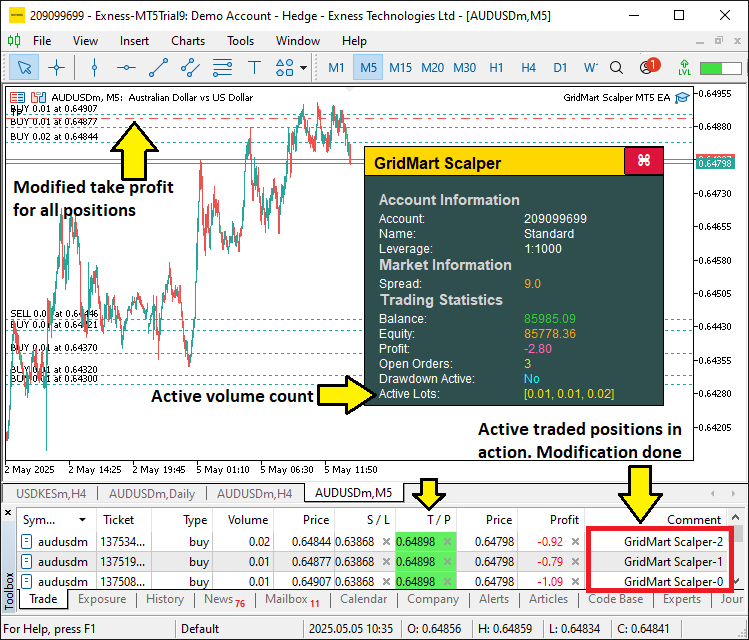
From the image, we can see that we have opened orders that are already in management mode. We just now need to apply the risk management logic for monitoring daily drawdown and limiting it. For this, we will a function to do all the tracking and stop the program when necessary as follows.
//+------------------------------------------------------------------+ //| Monitor daily drawdown and control trading state | //+------------------------------------------------------------------+ void MonitorDailyDrawdown() { //--- Initialize daily profit accumulator double totalDayProfit = 0.0; //--- Get current time datetime end = TimeCurrent(); //--- Get current date as string string sdate = TimeToString(TimeCurrent(), TIME_DATE); //--- Convert date to datetime (start of day) datetime start = StringToTime(sdate); //--- Set end of day (24 hours later) datetime to = start + (1 * 24 * 60 * 60); //--- Check if daily reset is needed if (dailyResetTime < to) { //--- Update reset time dailyResetTime = to; //--- Store current balance as daily starting balance dailyBalance = GetAccountBalance(); } //--- Select trade history for the day HistorySelect(start, end); //--- Get total number of deals int totalDeals = HistoryDealsTotal(); //--- Iterate through trade history for (int i = 0; i < totalDeals; i++) { //--- Get deal ticket ulong ticket = HistoryDealGetTicket(i); //--- Check if deal is a position close if (HistoryDealGetInteger(ticket, DEAL_ENTRY) == DEAL_ENTRY_OUT) { //--- Calculate deal profit (including commission and swap) double latestDayProfit = (HistoryDealGetDouble(ticket, DEAL_PROFIT) + HistoryDealGetDouble(ticket, DEAL_COMMISSION) + HistoryDealGetDouble(ticket, DEAL_SWAP)); //--- Accumulate daily profit totalDayProfit += latestDayProfit; } } //--- Calculate starting balance for the day double startingBalance = GetAccountBalance() - totalDayProfit; //--- Calculate daily profit/drawdown percentage double dailyProfitOrDrawdown = NormalizeDouble((totalDayProfit * 100 / startingBalance), 2); //--- Check if drawdown limit is exceeded if (dailyProfitOrDrawdown <= DRAWDOWN_LIMIT) { //--- Close all positions if configured if (CLOSE_ON_DRAWDOWN) CloseAllPositions(); //--- Disable trading tradingEnabled = false; } else { //--- Enable trading tradingEnabled = true; } } //+------------------------------------------------------------------+ //| Close all open positions managed by the EA | //+------------------------------------------------------------------+ void CloseAllPositions() { //--- Iterate through open positions for (int i = PositionsTotal() - 1; i >= 0; i--) { //--- Get position ticket ulong ticket = PositionGetTicket(i); //--- Select position by ticket if (ticket > 0 && PositionSelectByTicket(ticket)) { //--- Check if position belongs to this EA if (GetPositionSymbol() == _Symbol && GetPositionMagic() == MAGIC) { //--- Close the position obj_Trade.PositionClose(ticket); } } } }
To enforce risk management, we implement the "MonitorDailyDrawdown" function to track daily performance, using TimeCurrent and TimeToString to set the day’s time range, and HistorySelect to access trade history. We calculate total profit with HistoryDealGetTicket and HistoryDealGetDouble functions, normalize drawdown percentage via NormalizeDouble, and adjust "tradingEnabled" based on "DRAWDOWN_LIMIT", calling the "CloseAllPositions" function if "CLOSE_ON_DRAWDOWN" is true.
We define "CloseAllPositions" to iterate positions with "PositionsTotal" and PositionGetTicket, closing relevant trades using "PositionClose" from "obj_Trade" after verifying with "GetPositionSymbol" and "GetPositionMagic", ensuring robust drawdown control. We can then call this function on every tick to make the risk management when eligible.
//--- Monitor daily drawdown if enabled if (ENABLE_DAILY_DRAWDOWN) MonitorDailyDrawdown();
We check the "ENABLE_DAILY_DRAWDOWN" condition to determine if drawdown control is active and if true, we call the "MonitorDailyDrawdown" function to evaluate daily profit and loss, adjust "tradingEnabled", and potentially close positions, safeguarding the account against excessive losses. Upon compilation, we have the following outcome.
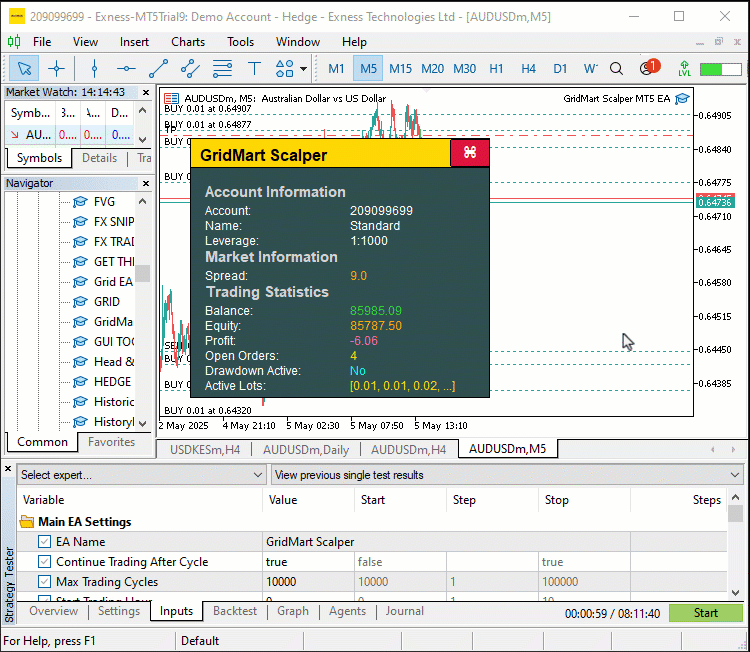
From the visualization, we can see that we can open the positions, manage them dynamically, and close them once the targets are reached, hence achieving our objective of creating the grid-mart strategy setup. The thing that remains is backtesting the program, and that is handled in the next section.
Backtesting
After thorough backtesting, we have the following results.
Backtest graph:
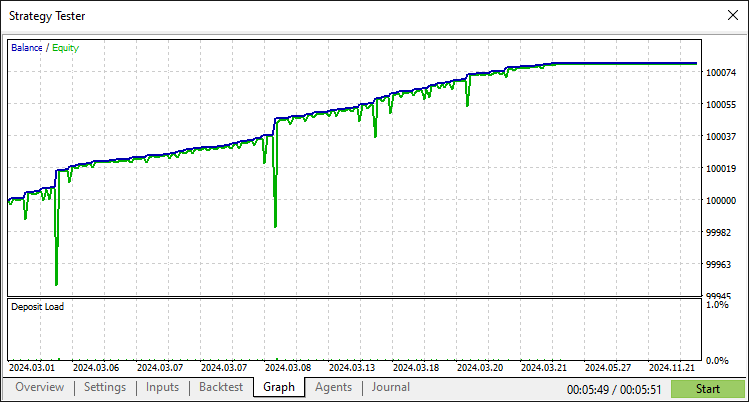
Backtest report:
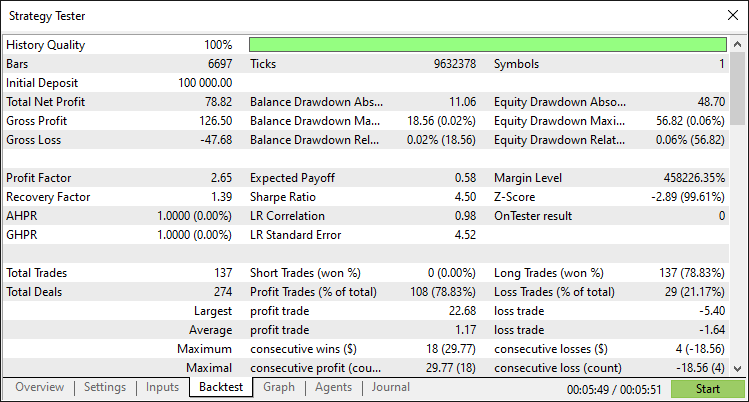
Conclusion
In conclusion, we have developed an MQL5 program that automates the Grid-Mart Scalping Strategy, executing grid-based Martingale trades with a dynamic dashboard for real-time monitoring of key metrics like spread, profit, and lot sizes. With precise trade execution, robust risk management through drawdown controls, and an interactive interface, you can further enhance this program by tailoring its parameters or integrating additional strategies to suit your trading preferences.
Disclaimer: This article is for educational purposes only. Trading carries significant financial risks, and market volatility may result in losses. Thorough backtesting and careful risk management are crucial before deploying this program in live markets.
By mastering these techniques, you can enhance this program further to make it more robust or use it as a backbone for developing other trading strategies, empowering your algorithmic trading journey.
Warning: All rights to these materials are reserved by MetaQuotes Ltd. Copying or reprinting of these materials in whole or in part is prohibited.
This article was written by a user of the site and reflects their personal views. MetaQuotes Ltd is not responsible for the accuracy of the information presented, nor for any consequences resulting from the use of the solutions, strategies or recommendations described.
 Data Science and ML (Part 39): News + Artificial Intelligence, Would You Bet on it?
Data Science and ML (Part 39): News + Artificial Intelligence, Would You Bet on it?
 Custom Debugging and Profiling Tools for MQL5 Development (Part I): Advanced Logging
Custom Debugging and Profiling Tools for MQL5 Development (Part I): Advanced Logging
 Artificial Ecosystem-based Optimization (AEO) algorithm
Artificial Ecosystem-based Optimization (AEO) algorithm
 Neural Networks in Trading: Mask-Attention-Free Approach to Price Movement Forecasting
Neural Networks in Trading: Mask-Attention-Free Approach to Price Movement Forecasting
- Free trading apps
- Over 8,000 signals for copying
- Economic news for exploring financial markets
You agree to website policy and terms of use
Nice article, but there is a significant bug in CalculateSL.
Sure. Thanks. What's up with it?
Sure. Thanks. What's up with it?
You forgot handling sell side. Attached is the corrected version.
You forgot handling sell side. Attached is the corrected version.
Ooh. Yeah. Sure. It will be of great help to others. Thanks.